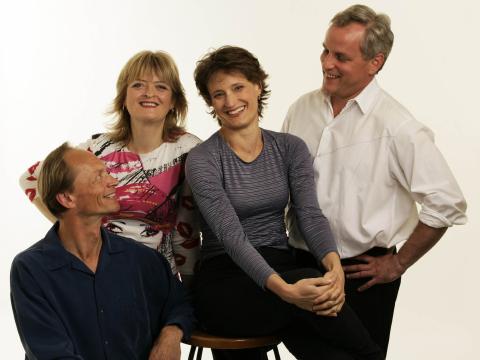|
<<< << -- 2 -- Malcolm Tattersall BEETHOVEN AND BLUE SKIES -- >> >>>

Saturday brought the first of the Concert Conversations, a new format for the morning concerts. Each day, Piers Lane will encourage the musicians to tell the audiences a little about themselves. The venue is the Masonic Temple in the city centre which would normally seat perhaps three hundred; set up with trestle tables for morning tea, as it is this week, the limit must be about two hundred. Not surprisingly, the series is almost booked out.
Saturday's artists were Jack Liebeck, Gwenneth Pryor and, again, the NZSQ. Caught between a concert tour of Korea and a recording engagement in Canada, if I remember correctly, the NZSQ will only be with us for a few days but those days are very full.
Pryor, brought up in Sydney, spoke about the study trip to London forty years ago which became permanent residence. Multi-talented violinist Liebeck entertained the audience with a yarn about one of his photographic assignments after talking about the strange career of a child prodigy.
Their concert comprised Mozart, Beethoven and Mendelssohn, standard fare but none the worse for that. The Piano Quartet in G minor, K478, was played by Pryor and three quarters of the NZSQ, in a good performance marred for me by the feeling that the piano was always a little too heavy to be the equal partner it needs to be. Liebeck and Pryor followed with the 'Spring' Sonata, buoyant and occasionally fiery. I can foresee Liebeck becoming a festival favourite: young and personable, able to speak entertainingly, and a very fine violinist, he certainly delighted Saturday's audience.
The NZSQ were alone together, for the first time here, in the Mendelssohn Quartet in Eb, Op 44 No 3. There have been no membership changes since 1994 and the continuity shows in their superb blend and balance. The slow movement fairly glowed with contentment and almost orchestral warmth; the scherzo scampered about happily in the manner of the Midsummer Night's Dream overture; and the finale was exuberant and brilliant -- molto allegro con fuoco according to the score, but con brio as well on this occasion. The programme notes make much of Mendelssohn's debt to Beethoven, and it is certainly audible, but his own trademarks are there too: lightness, grace, and a very high note rate.

The New Zealand String Quartet - left to right, Rolf Gjelsten, cello, Gillian Ansell, viola, Helene Pohl and Douglas Beilman, violins. Photo courtesy of AFCM
|
The Governor's Gala Concert on Saturday evening was varied indeed. It's easiest to discuss it out of order, pairing items by affinity.
The NZSQ was back (I said they were having a busy time, didn't I?) with more Mendelssohn. A late Capriccio (Op 81, No 3) opened the concert. Consisting of a slow introduction and a fast fugato, it was all over in five minutes, leaving us wanting more. We had to wait about an hour for that but it was a revelation when it did come: the String Quartet in A minor, Op 13, is a work which could modify a lot of preconceptions about its composer. Technically it is notable for its structural fluidity, timbral variety, and insistent use of imitative writing. Emotionally, it is a journey through the shadows, the margins of loss and alienation. It is an early work -- the composer was only eighteen -- and the influences of Beethoven's late quartets are not fully absorbed, but it is as rewarding as it is daring. I believe a Mendelssohn disc is one of the NZSQ's upcoming recording projects. If so, it will be well worth seeking out.
Continue >>
Copyright © 11 July 2007
Malcolm Tattersall, Townsville, Australia

|

